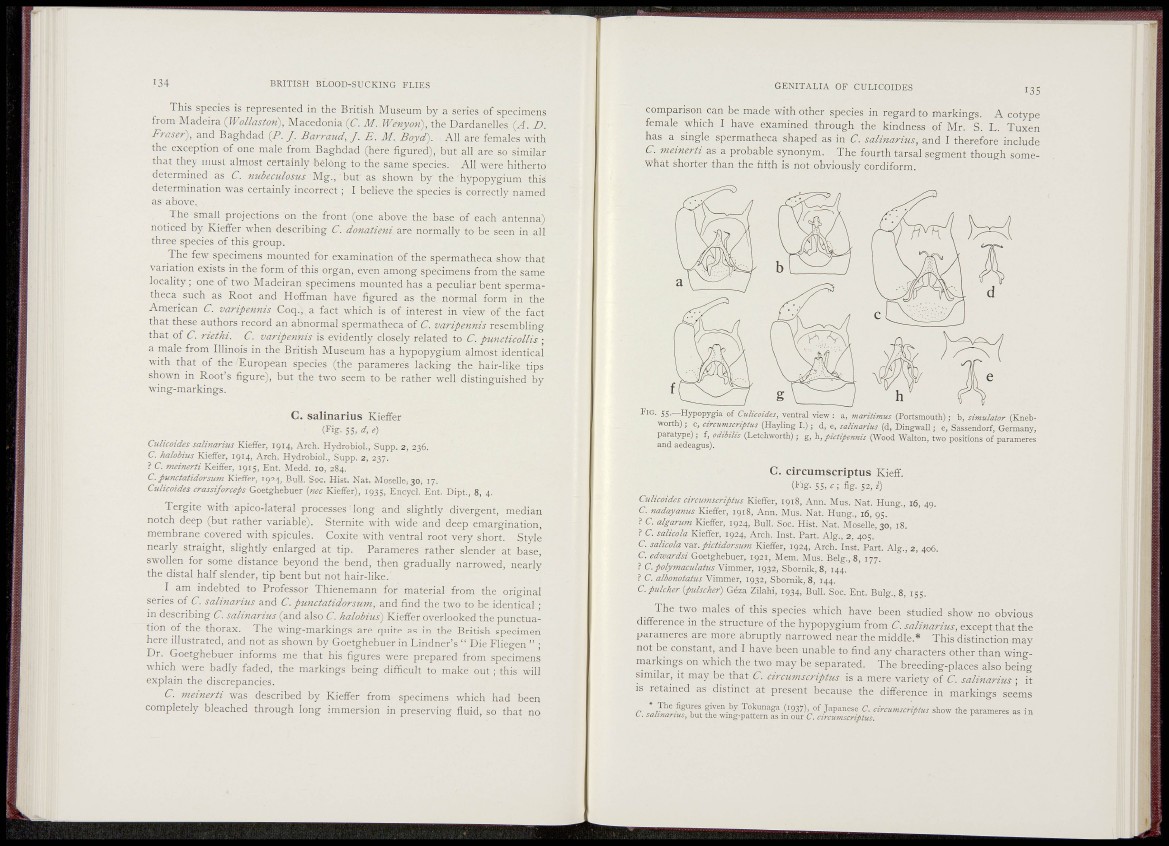
BRITISH BLOOD-SUCKING FLIES
This species is represented in the British Museum b}^ a series of specimens
from Madeira {Wollaston), Macedonia (C. M. Wenyon), the Dardanelles (A. D.
Fraser), and Baghdad (P. / . Barraud, J. E. M. Boyd). All are females with
the exception of one male from Baghdad (here figured), but all are so similar
that they must almost certainly belong to the same species. All were hitherto
determined as C. mibeculosus Mg., but as shown by the hypopygium this
determination was certainly incorrect ; I believe the species is correctly named
as above.
The small projections on the front (one above the base of each antenna)
noticed by Kieffer when describing C. donatieni are normally to be seen in all
three species of this group.
The few specimens mounted for examination of the spermatheca show that
variation exists in the form of this organ, even among specimens from the same
locality; one of two Madeiran specimens mounted has a peculiar bent spermatheca
such as Root and Hoffman have figured as the normal form in the
American C. varipennis Coq., a fact which is of interest in view of the fact
that these authors record an abnormal spermatheca of C. varipennis resembling
that of C. riethi. C. varipennis is evidently closely related to C. puncticollis ;
a male from Illinois in the British Museum has a hypopygium almost identical
with that of the European species (the parameres lacking the hair-like tips
shown in Root's figure), but the two seem to be rather well distinguished by
wing-markings.
C. salinarius Kieffer
(Fig. 55, d, e)
Culicoides salinarius Kieffer, 1914, Arch. Hydrobiol., Supp, 2, 236.
C. halobizts Kieffer, 1914, Arch. Hydrobiol., Supp. 2, 237.
? C. meinerti Keiffer, 1915, Ent. Medd. 10, 284.
C. punctatidorsuni Kieffer, 1924, Bull. Soc. Hist. Nat. Moselle, 30, 17.
Culicoides crassiforceps Goetghebuer (nec Kieffer), 1935, Encycl. Ent. Dipt., 8, 4.
Tergite with apico-lateral processes long and slightly divergent, median
notch deep (but rather variable). Sternite with wide and deep emargination,
membrane covered with spicules. Coxite with ventral root very short. Style
nearly straight, slightly enlarged at tip. Parameres rather slender at base,
swollen for some distance beyond the bend, then gradually narrowed, nearly
the distal half slender, tip bent but not hair-like.
I am indebted to Professor Thienemann for material from the original
series of C. saliriarius and C. punctatidorsum, and find the two to be identical ;
in describing C. salinarius (and also C. halobius) Kieffer overlooked the punctuation
of the thorax. The wing-markings are quite as in the British specimen
here illustrated, and not as shown by Goetghebuer in Lindner's " Die Fliegen " ;
Dr. Goetghebuer informs me that his figures were prepared from specimens
which were badly faded, the markings being difficult to make out ; this will
explain the discrepancies.
C. 7neinerti was described by Kieffer from specimens which had been
completely bleached through long immersion in preserving fluid, so that no
GENITALIA OF CULICOIDES 135
comparison can be made with other species in regard to markings. A cotype
female which I have examined through the kindness of Mr. S. L. Tuxen
has a single spermatheca shaped as in C. salinarius, and I therefore include
C. meinerti as a probable synonym. The fourth tarsal segment though somewhat
shorter than the fifth is not obviously cordiforra.
Fig. SS-—Hypopygia of Culicoides, ventral «ew : a, maritimus (Portsmouth); b, simulator (Knebworth);
c, circumscriptus (Hayling I.); d, e, salinarius (d, Ding^-all; e, Sassendorf, Germany,
paratype); f, odibilis (Letchworth); g, \ pictipennis (Wood Walton, two positions of parameres
and aedeagus).
C. circumscriptus Kieff.
(Fig. 55, c ; fig. 52, i)
Culicoides circmnscriptus Kieffer, 1918, Ann. Mus. Nat. Hung., 16, 49.
C. nadayanus Kieffer, 1918, Ann. Mus. Nat. Hung., 16, 95.
? C. alganmt Kieffer, 1924, Bull. Soc. Hist. Nat. Aloselle, 30, 18.
C. salicola Kieffer, 1924, Arch. Inst. Part. Alg., 2, 405.
C. salicola vs.r. pictidorsu?/i Kieffer, 1924, Arch. Inst. Part. Alg., 2, 406.
C. edwardsi Goetghebuer, 1921, Mem. Mus. Belg., 8, 177.
? C. polymaculatus V\mmtr, 1932, Sbornik, 8, 144.
? C. albonotatiis Vimmer, 1932, Sbornik, 8, 144.
C.pulcher (puhcher) Geza Zilahi, 1934, Bull. Soc. Ent. Bulg., 8, 155.
The two males of this species which have been studied show no obvious
difference in the structure of the hypopygium from C. salinarius, except that the
parameres are more abruptly narrowed near the middle.* This distinction may
not be constant, and I have been unable to find any characters other than wingmarkings
on which the two may be separated. The breeding-places also being
similar, it may be that C. circumscriptus is a mere variety of C. salinarius ; it
is retained as distinct at present because the difference in markings seems
* Tlie figures given by Tokunaga (1937), of Japanese C. circumscriptus show the parameres as in
C. sahnartus, but the wing-pattern as in our C. circumscriptus. P-rameres as in